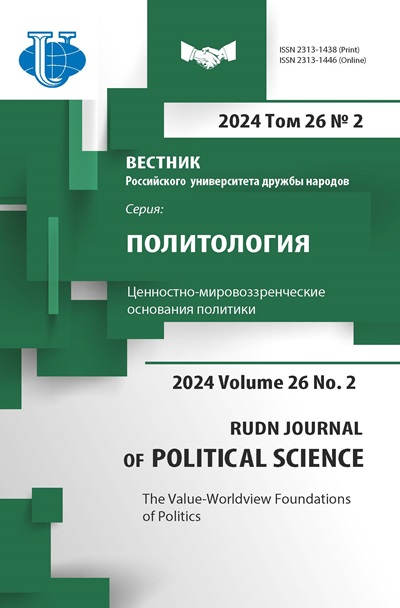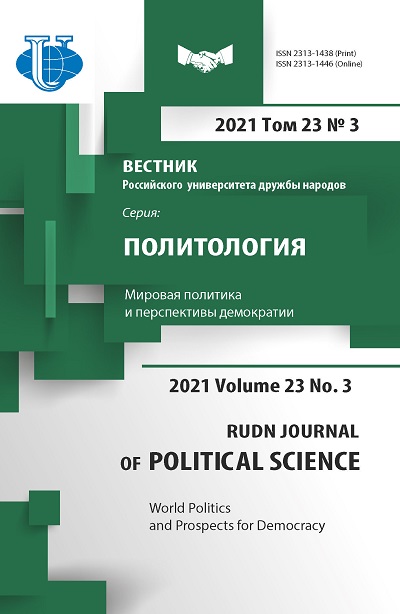Польша и Венгрия: демократический откат и сдвиг политического ландшафта Европы
- Авторы: Эверетт Д.1
-
Учреждения:
- Национальный исследовательский университет «Высшая школа экономики»
- Выпуск: Том 23, № 3 (2021): Мировая политика и перспективы демократии
- Страницы: 394-406
- Раздел: ГЕОПОЛИТИКА И ПЕРСПЕКТИВЫ ДЕМОКРАТИИ
- URL: https://journals.rudn.ru/political-science/article/view/27305
- DOI: https://doi.org/10.22363/2313-1438-2021-23-3-394-406
Цитировать
Полный текст
Аннотация
Фокусом представленной работы является роль Польши и Венгрии в изменении общеевропейского политического ландшафта, особенно с учетом предполагаемого отхода этих стран от демократических стандартов в последние годы. Используется методология количественной оценки влияния внутриполитических факторов, в особенности связанных с режимной трансформацией, на внешнюю политику Польши и Венгрии, с акцентом на их взаимоотношениях с Европейским союзом. Кейсы анализируются в контексте обширной литературы по волнам и откатам демократизации, а также в свете теории демократической консолидации. Рассматривается вопрос о том, являлись ли Польша и Венгрия полноценными консолидированными демократиями. Также исследуется становление коалиции Польши и Венгрии; обсуждаются роль этих двух стран в продвижении более жесткой иммиграционной политики во время европейского миграционного кризиса, а также будущая роль Польши и Венгрии в ЕС. Делается вывод о том, что Польша и Венгрия намерены активно влиять на устройство ЕС и европейскую политику в целом как с помощью инструментов давления, формирования повестки и лидерства, в частности во время миграционного кризиса, так и посредством создания новой политической группы влияния.
Ключевые слова
Об авторах
Джудас Эверетт
Национальный исследовательский университет «Высшая школа экономики»
Автор, ответственный за переписку.
Email: judas.everett@gmail.com
ORCID iD: 0000-0003-0794-0153
аспирант Аспирантской школы по политическим наукам
Москва, Российская ФедерацияСписок литературы
- Badie, B., Berg-Schlosser, D., & Morlino, L. (Eds.). (2011). International encyclopedia of political science. SAGE Publications.
- Bakke, E., & Sitter, N. (2020). The EU’s enfants terribles: Democratic backsliding in Central Europe since 2010. Perspectives on Politics, 1-16.
- Baldwin-Edwards, M., Blitz, B.K., & Crawley, H. (2019). The politics of evidence-based policy in Europe’s ‘migration crisis.’ Taylor, Francis.
- Bermeo, N. (2016). On democratic backsliding. Journal of Democracy, 27(1), 5-19.
- Bozóki, A., & Ishiyama, J.T. (Eds.). (2002). The communist successor parties of Central and Eastern Europe. Routledge.
- Csehi, R., & Zgut, E. (2021). ‘We won’t let Brussels dictate us’: Eurosceptic populism in Hungary and Poland. European Politics and Society, 22(1), 53-68.
- Ekiert, G., & Kubik, J. (1998). Contentious Politics in New Democracies: East Germany, Hungary, Poland, and Slovakia, 1989-93. World Politics, 50(4), 547-581. JSTOR.
- Gorokhovskaia, Y. (2017). Democratic consolidation [Data set]. Oxford University Press. https://doi.org/10.1093/obo/9780199756223-0224
- Goździak, E.M., & Márton, P. (2018). Where the wild things are: Fear of Islam and the anti-refugee rhetoric in Hungary and in Poland. Central and Eastern European Migration Review, 7(2), 125-151.
- Holesch, A., & Kyriazi, A. (2020). Democratic backsliding in the European Union: The role of the Hungarian-Polish coalition. East European Politics, 1-20.
- Huntington, S.P. (1991). Democracy’s Third Wave. Journal of Democracy, 2(2), 12-34. https://doi.org/ 10.1353/jod.1991.0016
- Gunitsky, S. (2018). Democratic Waves in Historical Perspective. Perspectives on Politics, 16(3), 634-651. https://doi.org/10.1017/S1537592718001044
- Jasiecki, K. (2018). “Conservative modernization” and the rise of law and justice in Poland. In New conservatives in Russia and East Central Europe (pp. 130-153). Routledge
- Kelemen, R.D., & Pech, L. (2019). The uses and abuses of constitutional pluralism: Undermining the rule of law in the name of constitutional identity in Hungary and Poland. Cambridge Yearbook of European Legal Studies, 21, 59-74
- Lévesque, J. (1997). The enigma of 1989: The USSR and the liberation of Eastern Europe. University of California Press.
- Levitsky, S., & Ziblatt, D. (2018). How democracies die (First edition). Crown.
- Linz, J.J., & Stepan, A.C. (1996). Toward consolidated democracies. Journal of Democracy, 7(2), 14-33.
- Magyar, B., & Madlovics, B. (2020). The anatomy of post-communist regimes: A conceptual framework. Central European University Press.
- Magyar, B., & Vásárhelyi, J. (Eds.). (2017). Twenty-five sides of a post-communist Mafia state. CEU Press.
- Nyyssönen, H. (2018). The East is different, isn’t it?-Poland and Hungary in search of prestige. Journal of Contemporary European Studies, 26(3), 258-269.
- Öniş, Z., & Kutlay, M. (2020). Reverse transformation? Global shifts, the core-periphery divide and the future of the EU. Journal of Contemporary European Studies, 28(2), 197-215.
- Sata, R., & Karolewski, I.P. (2020). Caesarean politics in Hungary and Poland. East European Politics, 36(2), 206-225.
- Szawiel, T. (2009). Democratic consolidation in Poland: Support for democracy, civil society and the party system. Polish Sociological Review, 168, 483-506. JSTOR.
- Vachudova, A. (2020). Ethnopopulism and democratic backsliding in Central Europe. East European Politics, 36(3), 318-340.
- Waldner, D., & Lust, E. (2018). Unwelcome change: Coming to terms with democratic backsliding. Annual Review of Political Science, 21(1), 93-113. https://doi.org/10.1146/annurev-polisci-050517-114628
















